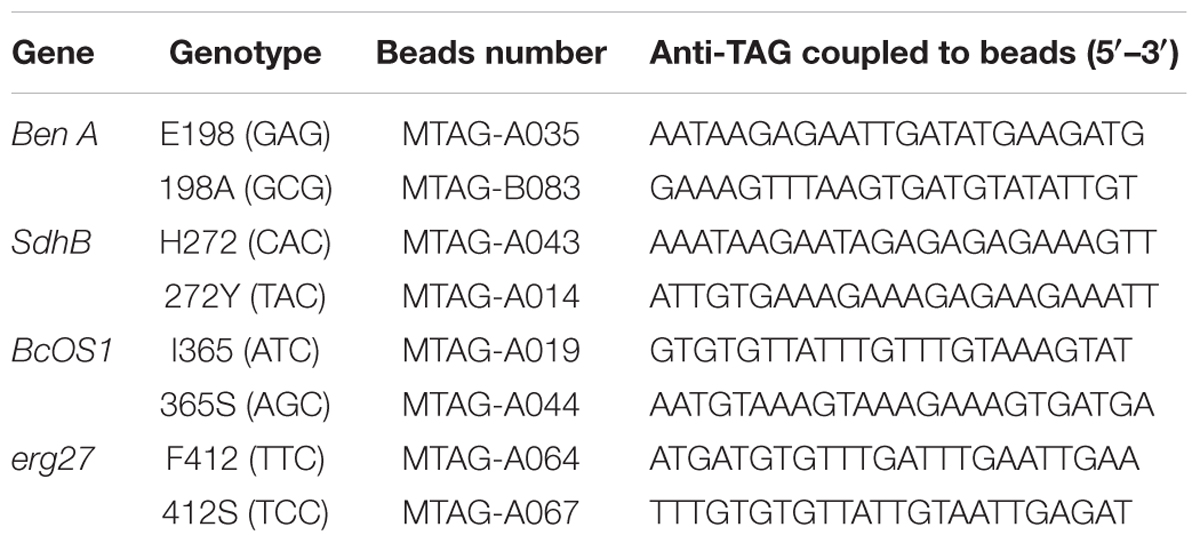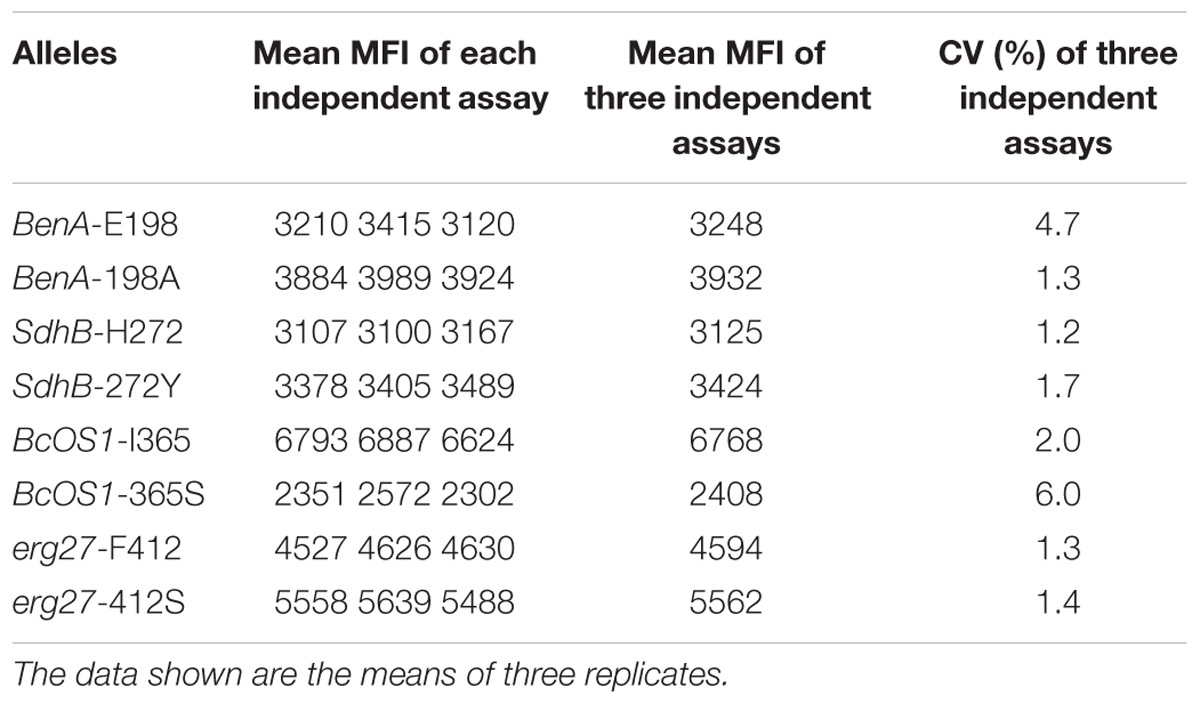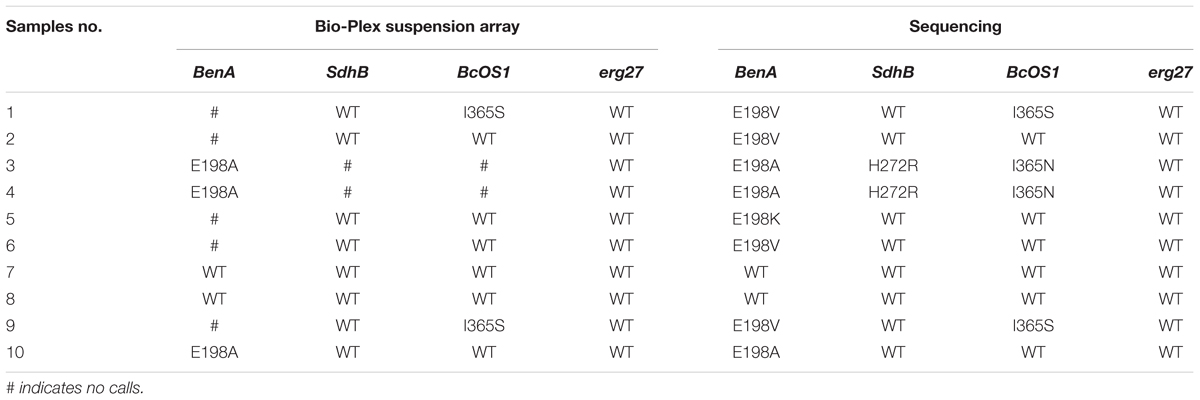- College of Life Science and Bioengineering, Beijing University of Technology, Beijing, China
A simple and high-throughput assay to detect fungicide resistance is required for large-scale monitoring of the emergence of resistant strains of Botrytis cinerea. Using suspension array technology performed on a Bio-Plex 200 System, we developed a single-tube allele-specific primer extension assay that can simultaneously detect eight alleles in one reaction. These eight alleles include E198 and 198A of the β-Tubulin gene (BenA), H272 and 272Y of the Succinate dehydrogenase iron–sulfur subunit gene (SdhB), I365 and 365S of the putative osmosensor histidine kinase gene (BcOS1), and F412 and 412S of the 3-ketoreductase gene (erg27). This assay was first established and optimized with eight plasmid templates containing the DNA sequence variants BenA-E198, BenA-198A, SdhB-H272, SdhB-272Y, BcOS1-I365, BcOS1-365S, erg27-F412, and erg27-412S. Results indicated that none of the probes showed cross-reactivity with one another. The minimum limit of detection for these genotypes was one copy per test. Four mutant plasmids were mixed with 10 ng/μL wild-type genomic DNA in different ratios. Detection sensitivity of mutant loci was 0.45% for BenA-E198A, BcOS1-I365S, and erg27-F412S, and was 4.5% for SdhB-H272Y. A minimum quantity of 0.1 ng of genomic DNA was necessary to obtain reliable results. This is the first reported assay that can simultaneously detect mutations in BenA, SdhB, BcOS1, and erg27.
Introduction
Botrytis cinerea is the causal agent of gray mold, which often causes heavy losses on many economically important crops, including vegetables, fruits, ornamentals, and bulbs. B. cinerea can attack leaves, stems, fruits, and even stored and transported agricultural products (Mbengue et al., 2016). It has been named one of the top 10 fungal pathogens in molecular plant pathology (Dean et al., 2012). Synthetic fungicides are widely used for controlling disease caused by B. cinerea. A few years after the introduction of fungicides, development of resistance in pathogen populations was observed, and B. cinerea was one of the first fungi for which resistance was described (Yourman et al., 2001; Hahn, 2014).
Isolates of B. cinerea that are resistant to benzimidazole (e.g., carbendazim, benomyl), succinate dehydrogenase inhibitors (SDHIs) (e.g., boscalid), dicarboximide (e.g., iprodione and procymidone), and sterol biosynthesis inhibitors (SBIs) (e.g., fenhexamid) are distributed worldwide (Yourman et al., 2000; Bardas et al., 2010; Leroux et al., 2010; Van der Heyden et al., 2014; Fernandez-Ortuno et al., 2015). Increasing occurrence of fungicide resistant B. cinerea has become a serious problem for disease control.
The most important resistance mechanism of B. cinerea is modification of the fungicide target caused by mutations in the encoding genes. Point mutations at codon 198 or 200 in the β-Tubulin gene (BenA) are related to benzimidazole resistance (Leroux et al., 2002). E198A mutant strains that possess amino acid replacement of glutamic acid by alanine have been detected worldwide as major benzimidazole-resistant strains in the field (Banno et al., 2008). A histidine to tyrosine replacement at codon 272 (H272Y) in Succinate dehydrogenase iron–sulfur subunit gene (SdhB) is responsible for the boscalid resistance phenotype (Yin et al., 2011). Resistance to dicarboximide can be associated with point mutations in the putative osmosensor histidine kinase gene (BcOS1), and strains possessing the I365S mutation are dominant (Cui et al., 2002; Oshima et al., 2002). A mutation at codon 412 (F412S) in the 3-ketoreductase gene (erg27) that causes amino acid replacement of a phenylalanine residue by serine is related to fenhexamid resistance (Debieu et al., 2013).
At present, many molecular methods have been used to detect fungicide resistance in B. cinerea, including sequencing (Leroux et al., 2010; Fillinger et al., 2012), polymerase chain reaction restriction fragment length polymorphism (PCR-RFLP; Ishii et al., 2009; Van der Heyden et al., 2014), allele-specific PCR (AS PCR; De Miccolis et al., 2012, 2014; Yin et al., 2012; Van der Heyden et al., 2014), tetra-primer amplification refractory mutation systems (ARMSs) PCR (Munoz et al., 2009), real-time PCR (Banno et al., 2008; Billard et al., 2012), and high-resolution melting (HRM) analysis (Chatzidimopoulos et al., 2014). However each of these molecular assays can only detect a single allele or simultaneously detect different alleles in a single gene. Simultaneous detection of multiple alleles in a single reaction vessel is a technical difficulty in fungicide resistance identification. Increasing fungicide resistance has been a serious problem in disease control. Undoubtedly, investigating the large numbers of strains resistant to different kinds of fungicides requires massive effort. Therefore, a simple and high-throughput genotyping assay is required for large scale detection and monitoring of the emergence of resistant strains of B. cinerea.
The Bio-Plex® suspension array could be potential candidate for developing such a genotyping tool. The Bio-Plex® suspension array is based on the flexible multi-analyte profiling (xMAP) technology (Houser, 2012). It enables multiplex biological testing of up to 500 analytes within a single sample volume (Spierings and Dunbar, 2013). These 500 analytes are realized by 500 distinctly colored bead sets created by the use of three fluorescent dyes at different ratios. Each bead couples to sequence-specific capture oligos that recognize and bind target DNAs. Once bound, target DNA molecules, which are labeled with biotin, are tagged with Streptavidin-R-phycoerythrin (SAPE; Dunbar, 2006; Figure 1). The beads are individually analyzed by cytometry on the Bio-Plex 200 platform. A red laser distinguishes the internal bead dyes to identify each microsphere particle, and a green laser provides a quantitative result of the target molecules. Many applications for nucleic acid assay have been developed using bead-based technology, including single nucleotide polymorphism (SNP) analysis (Ozaki et al., 2012, 2014; Spierings and Dunbar, 2013; Lee et al., 2015; Thierry and Derzelle, 2015), gene expression analysis (Yang et al., 2001; Naciff et al., 2005), microRNA analysis (Wang et al., 2012; Li et al., 2014), and microbiological detection (Dunbar and Jacobson, 2007; Preuner and Lion, 2013; Glushakova et al., 2015).
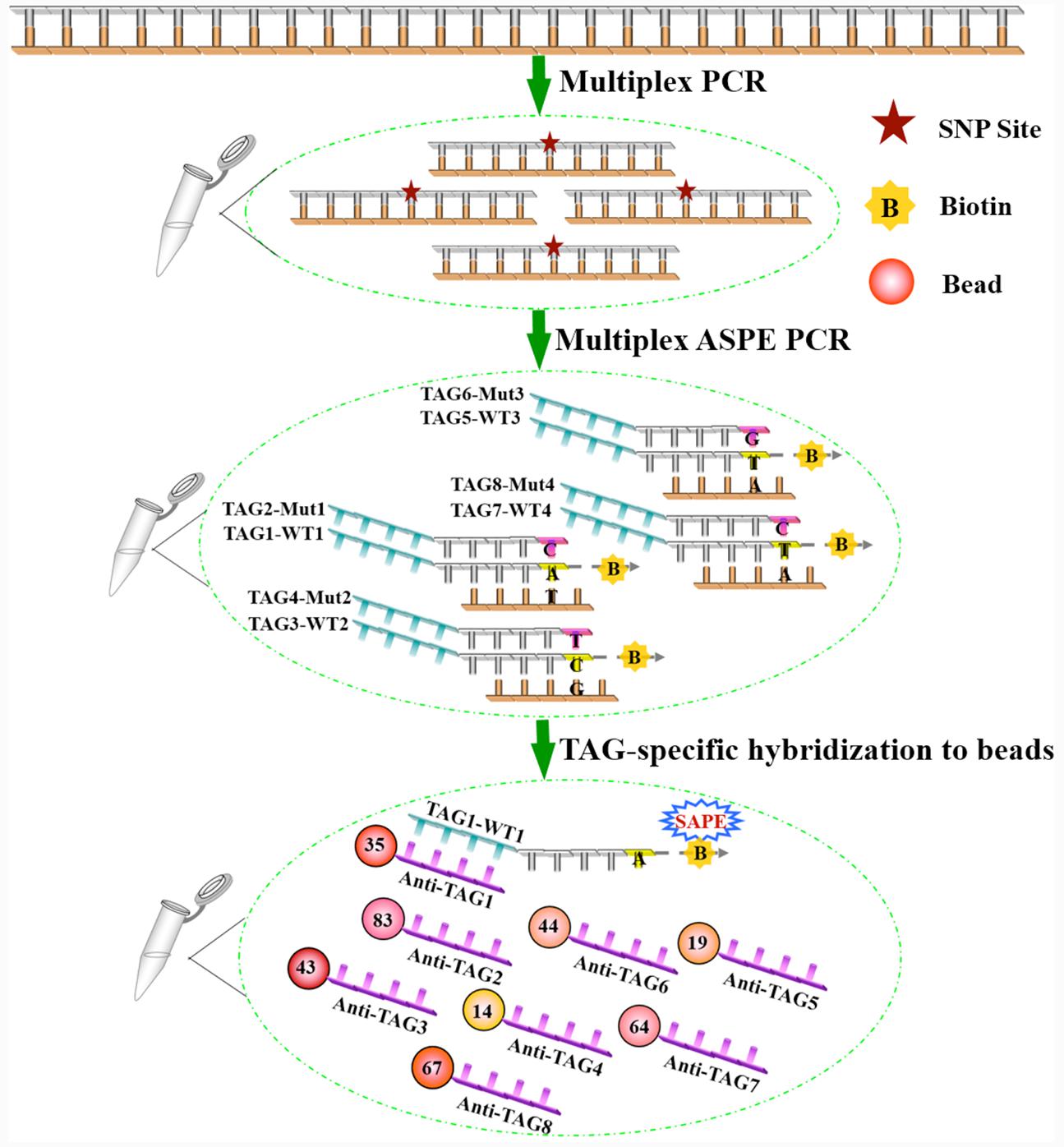
FIGURE 1. Schematic illustration of the suspension assay. The target regions BenA, SdhB, BcOS1, and erg27 containing SNPs are amplified by 4-plex PCR in a single tube. TAG-ASPE primers overlap the SNP site in the PCR-amplified target DNA, and only perfectly matching primers can be extended (eight TAG-ASPE primers were mixed in one reaction). Biotin-labeled extended products then hybridize to the microsphere coupled with anti-TAG sequences and are detected on the Bio-Plex platform.
This study established a novel and universal multiplex genotyping method. We describe a genotyping assay that combines an allele-specific primer extension (ASPE) with the Bio-Plex suspension array. Four mutations most commonly associated with fungicide resistance in B. cinerea are included in this assay, including BenA (E198A), SdhB (H272Y), BcOS1 (I365S), and erg27 (F412S). The development of this multiplex assay will greatly reduce the time, labor, and cost of screening compared to single-reaction-based detection methods. It represents important progress in the development of multiplex genotyping technologies for molecular detection of fungicide-resistance in B. cinerea.
Materials and Methods
Strains and Culture Conditions
The Bc05.10 strain of B. cinerea used as a sensitive strain was provided by Jingao Dong of the Agricultural University of Hebei (Hebei, China). Field strains resistant to different types of fungicides were provided by Chaoxi Luo of the Huazhong Agricultural University (Hubei, China). B. cinerea isolates were incubated on potato dextrose agar (PDA) medium at 22°C for 5 days. To extract genomic DNA, mycelial disks of B. cinerea isolates were cultured in potato dextrose (PD) liquid medium at 22°C for 7 days. After 7 days incubation, mycelia were harvested by filtration through sterile filter paper, and dried between two layers of filter paper. Fungal material was frozen at -80°C for later use.
DNA Extraction and Plasmid Construction
Genomic DNA was extracted from each isolate using a previously described modification of the CTAB (Agbagwa et al., 2012). Template DNA was stored at -20°C until use. Based on the B. cinerea sequence of BenA, SdhB, BcOS1, and erg27 in GenBank (accession numbers Z69263, AY726618, AF435964, and AY220532), eight nucleotide sequences containing the variants BenA-E198 (GAG), BenA-198A (GCG), SdhB-H272 (CAC), SdhB-272Y (TAC), BcOS1-I365 (ATC), BcOS1-365S (AGC), erg27-F412 (TTC), and erg27-412S (TCC) were cloned into pUCm-T plasmids (Shanghai Sangon, CN). Gene splicing by overlap extension PCR was used for site-directed mutagenesis. All plasmid DNA constructs were confirmed by DNA sequencing. These plasmids were used to optimize reaction conditions and determine the analytical sensitivity and specificity of the bead-based suspension array. Genomic DNA and plasmid DNA were quantified using a NanoDrop 1000 Spectrophotometer (Thermo Scientific, USA).
Primers and TAG Sequences
All primers used in multiplex PCR and ASPE PCR were designed using the software primer premier 5. TAG sequences were designed by the Luminex Corporation. All oligonucleotides used in the assay were purified by HPLC and are listed in Tables 1–3.
Multiplex PCR (4-Plex)
Multiplexed PCR to amplify the SNP-containing target regions BenA, SdhB, BcOS1, and erg27 was performed in 25 μL reaction mixtures. Reactions consisted of 1 ng genomic DNA template of the Bc05.10 isolate (or different concentrations of plasmid DNAs), 1× PCR reaction buffer (-Mg2+), 1.5 mM MgCl2, 0.2 mM dNTP (TaKaRa, Japan), 2 Units of Platinum Taq DNA polymerase (Invitrogen, Carlsbad, CA, USA), 0.05 μM of each BenA primer, 0.4 μM of each SdhB primer, and 0.2 μM of the other primers. Details of multiplexed PCR primers are listed in Table 1. Sterile double distilled H2O (ddH2O) was used as a negative control. PCR was conducted in a thermal cycler as follows: 5 min at 94°C and 35 cycles of 30 s at 94°C, 30 s at 54°C and 30 s at 72°C, with a final extension at 72°C for 10 min, and was kept at 4°C until use. To remove unused primers, 3 μL of ExoSAP-IT (Affymetrix, SE) was added to 7.5 μL PCR products. This mixture was incubated in a thermal cycler at 37°C for 30 min, at 80°C for 15 min, and was then held at 4°C.
Multiplex ASPE PCR
ExoSAP-IT-treated PCR product was used as the template for the Multiplex ASPE reaction. ASPE primers were designed a way that 3′ end was complementary to the wild-type (WT) or mutant (Mut) base for WT and Mut discrimination. The Platinum Tsp DNA polymerase (Invitrogen, Carlsbad, CA, USA) can synthesize new DNA containing biotin labeled nucleotides when the 3′ base of the ASPE primer is completely complementary, but no product can be generated if its 3′ base is mismatched. Each ASPE primer that identified a genotype required a unique TAG sequence on its 5′ end (Table 2). These TAG sequences were complementary to anti-TAG sequences coupled to microspheres. Multiplex ASPE PCR was performed with all eight TAG-ASPE primers in a single tube. ASPE reaction mixtures in a final 20 μL volume consisted of 1 μL ExoSAP-IT-treated PCR product, 20 mM Tris-HCl (pH 8.4), 50 mM KCl, 1.25 mM MgCl2, 0.75 U of Platinum Tsp DNA polymerase, 25 nM of each TAG-ASPE primer, and 5 μM each of dATP, dTTP, dGTP, and μM biotin-dCTP (Invitrogen, Carlsbad, CA, USA). Reaction mixtures were incubated at 96 for 2 min and 30 cycles at 94°C for 30 s, 55°C for 1 min, and 37°C for 2 min, with a final hold at 4°C until use.
Hybridization to MagPlex-TAG Microspheres and Detection
Approximately 2500 MagPlex-TAG microspheres (Luminex, USA) of each set per reaction were mixed in a single tube. This assay required eight microsphere sets corresponding to eight genotypes. The eight microbead types selected were 35, 83, 43, 14, 19, 44, 64, and 67 (Table 3). The mixture was diluted to 100 of each microsphere set per μL in 2×Tm Hybridization Buffer (0.4 M NaCl, 0.2 M Tris, 0.16% Triton X-100, pH 8.0), resuspended by vortexing and sonicated for approximately 20 s. The hybridization reaction was performed in a total volume of 50 μL containing 25 μL of the MagPlex-TAG microsphere mixture, 5 μL of each ASPE reaction, and 20 μL ddH2O. These mixtures were denatured at 95°C for 90 s and incubated at 37°C for 1 h. After incubation, samples were filtered through 1.2 μm MultiScreen® HTS-BV 96-well filtration plates (Merck Millipore, DE) and washed twice with 75 μL of 1× Tm Hybridization Buffer (0.2 M NaCl, 0.1 M Tris, 0.08% Triton X-100, pH 8.0). Microspheres were then resuspended in 120 μL of 1× Tm Hybridization Buffer containing 0.1% BSA and 2 μg/mL SAPE (Invitrogen, USA), transferred to new 96-well plates (Corning, NY, USA) and incubated at 37°C for 15 min. Samples at 50 μL were then analyzed at room temperature on the Bio-Plex 200 System (Bio-Rad, USA). For each sample, the median fluorescence intensity (MFI) of at least 100 beads was analyzed for each bead set.
Limits of Detection
To determine the limits of detection for each genotype, each plasmid was diluted to 104, 103, 102, 10, and 1 copies/uL and was tested with the multiplex suspension array. To determine the lowest concentration of genomic DNA of field isolates needed in the suspension assay, genomic DNA of the IR-2 strain (benzimidazole-resistant strain) was diluted to 10, 1, 0.1, and 0.01 ng/μL. One microliter was then used as the template for multiplex PCR. The detection limit and the lowest concentration of genomic DNA were defined as the values where all replicates gave positive results for each allele. All assays were performed three times.
Determination of Sensitivity
To determine sensitivity for each Mut allele, we mixed 10, 102, 103, 104, and 105 copies of Mut plasmid DNA with 10 ng genomic DNA (equivalent to 2.2 × 105 genomic DNA copies) as the template for 4-Plex PCR. These correspond to rates of 0.045, 0.45, 4.5, 45, and 450%. The lowest rate at which all three replicates were positive was defined as the sensitivity of the assay.
Data Analysis
For each sample tested with the Bio-Plex 200 system, MFI values were collected for each of the eight microsphere sets corresponding to each allele. Results can be exported from the Bio-Plex Manager 4.0 software into an Excel file. For each allele, NET MFI values were obtained by subtracting the respective no-target (multiplex PCR negative control) MFI values. A criterion was set as the mean MFI of 22 blank controls +5 standard deviation (SD). MFI values for each allele were required to meet this criterion, and alleles could then be determined based on allelic ratios (AR) as follows:
Based on preset criteria, AR was used to discriminate WT, mutant, and heterozygous samples. In this study, a mutant AR ≥ 0.03 was set to call the presence of BenA-198A, AR ≥ 0.2 was set to call the presence of SdhB-272Y, AR ≥ 0.02 was set to call the presence of BcOS1-365S, and AR ≥ 0.06 was set to call the presence of erg27-412S. When the AR was lower than these values, the WT was called. All data were analyzed and plotted using Excel 2013 or GraphPad prism 5.01.
Application to Field Isolates of B. cinerea
DNA samples from 10 field isolates of B. cinerea were analyzed using the Bio-Plex suspension array. One nanogram of genomic DNA was used as the template for multiplex PCR. To evaluate accuracy, genotyping results were compared with the results obtained by sequencing (Sangon, China).
Results
Multiplex PCR (4-Plex)
Multiplexed PCR of genomic DNA was performed under optimized conditions. The PCR products contained mutations of interest. Four expected PCR products were amplified in a single tube: 353 bp for BenA, 428 bp for SdhB, 223 bp for BcOS1, and 191 bp for erg27.
Specificity of Bio-Plex Suspension Array
The specificity of the assay was verified with amplimers of each individual plasmid. Then, PCR products were hybridized to all eight sets of microbeads. As shown in Figure 2, no cross-reactivity occurred between each probe. The mean background MFI for each allele ranged from 12 to 27, and the signal-to-noise ratio (positive MFI/ background) ranged from 81 to 137. Thus, the genotyping assay for these eight alleles was highly specific.
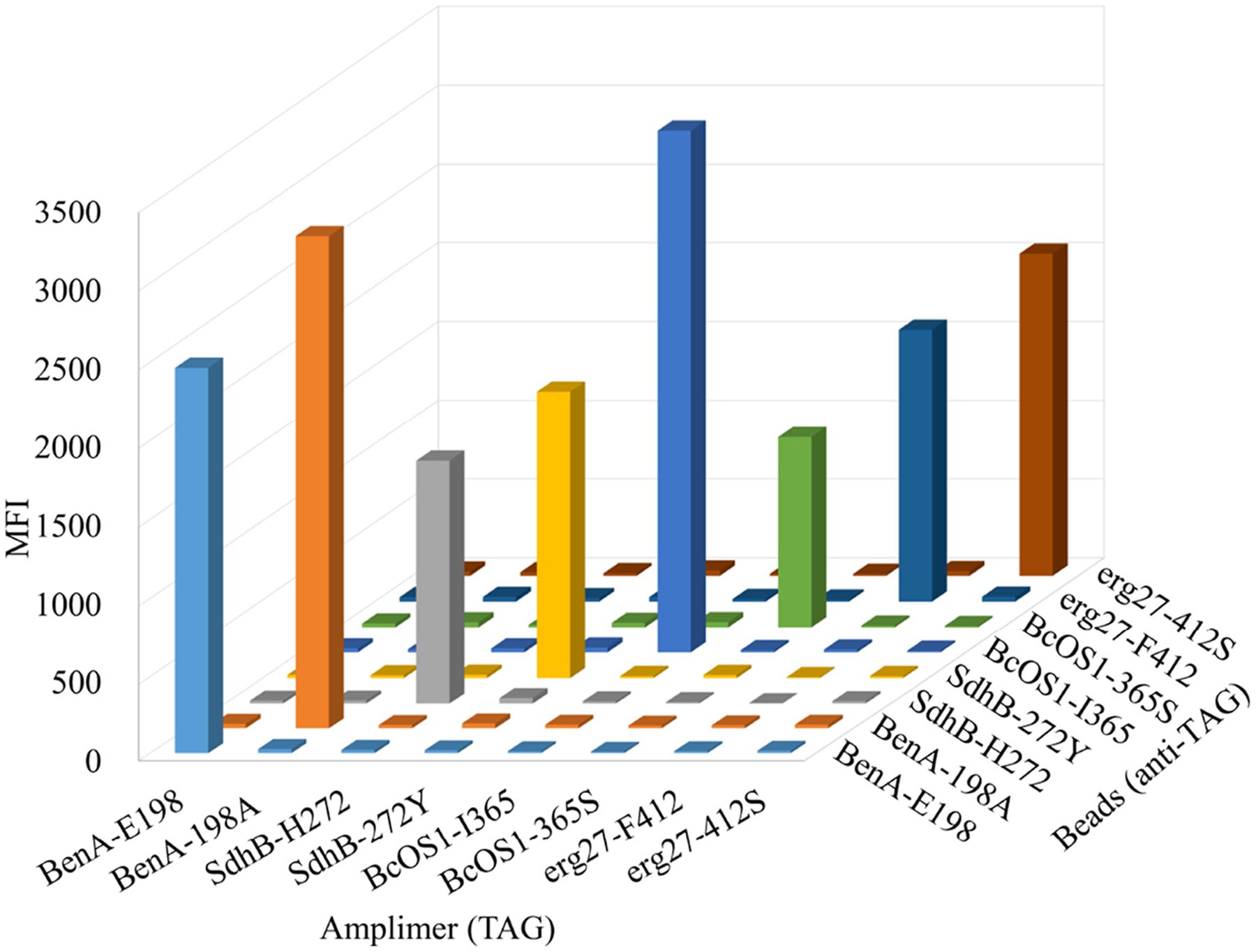
FIGURE 2. Specificity of bead-based assay. Individual plasmids (1 × 104 copies/test) representative of each of the eight alleles were used as the template in a 4-plex PCR to determine specificity. Results showed that median fluorescence intensity (MFI) values were all above 1200. The data shown are the means of three replicates.
Detection Limit
A series of 10-fold dilutions of each plasmid (1–104 copies/μL) were used to determine the limits of detection for this method. The results indicated that MFI values reached threshold values when DNA concentrations of BenA-E198 (GAG), SdhB-H272 (CAC), SdhB-272Y (TAC), erg27-F412 (TTC), and erg27-412S (TCC) plasmids were as low as 10 copies. MFI values reached threshold values when DNA concentrations of BenA-198A (GCG), BcOS1-I365 (ATC), and BcOS1-365S (AGC) plasmids were as low as 1 copy (Figure 3).
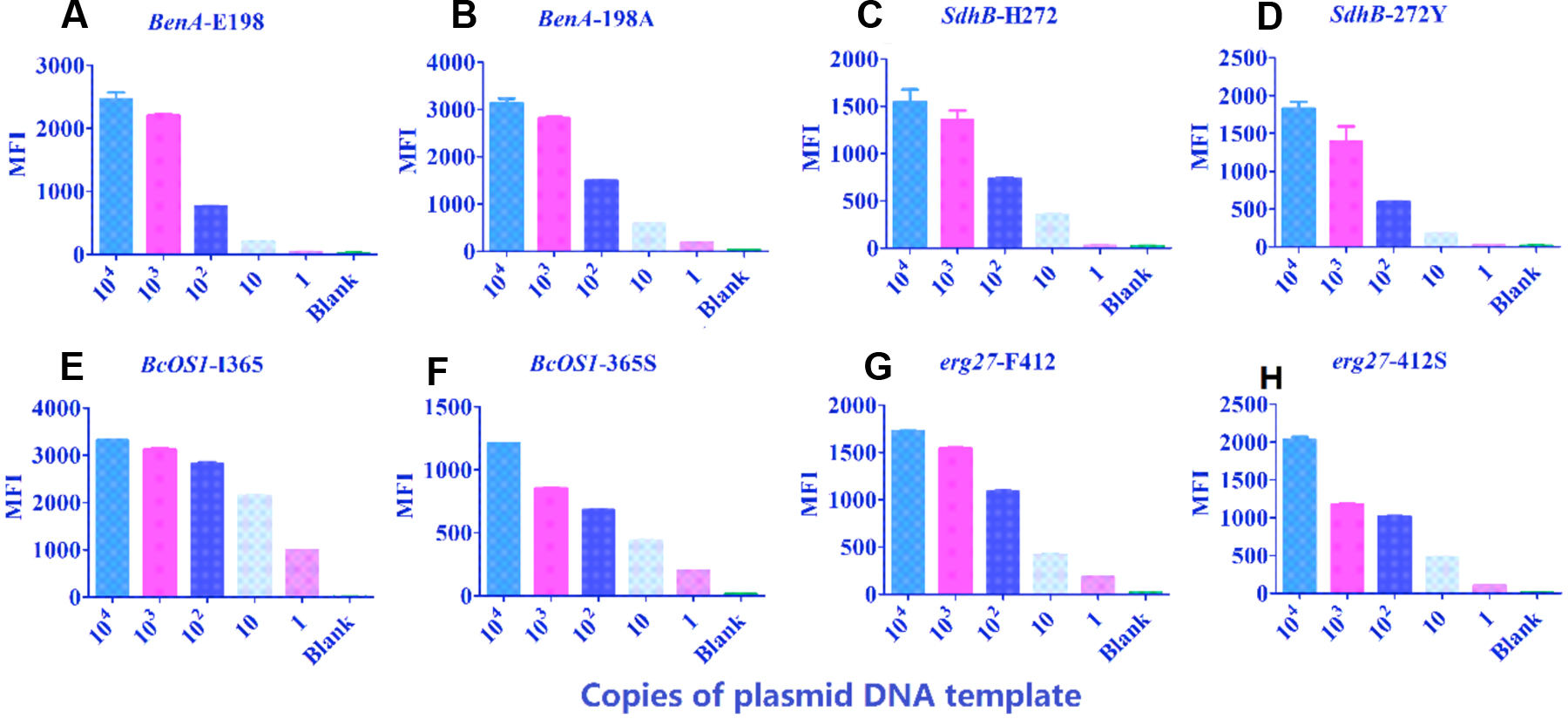
FIGURE 3. Detection limit of the assay. Ten-fold serial dilutions of the eight plasmids were tested with the suspension assay to determinate the limit of detection. (A) BenA-E198; (B) BenA-198A; (C) SdhB-H272; (D) SdhB-272Y; (E) BcOS1-I365; (F) BcOS1-365S; (G) erg-F412; (H) erg-412S. The data shown are the means plus standard deviation (SD) (error bars) (n = 3).
Genomic DNA of field isolate strains was serially diluted (0.01–10 ng/μL) to determine the lowest DNA concentration needed in the assay. Results showed that more than 0.1 ng of input DNA was required for discrimination of all eight alleles (Figure 4).
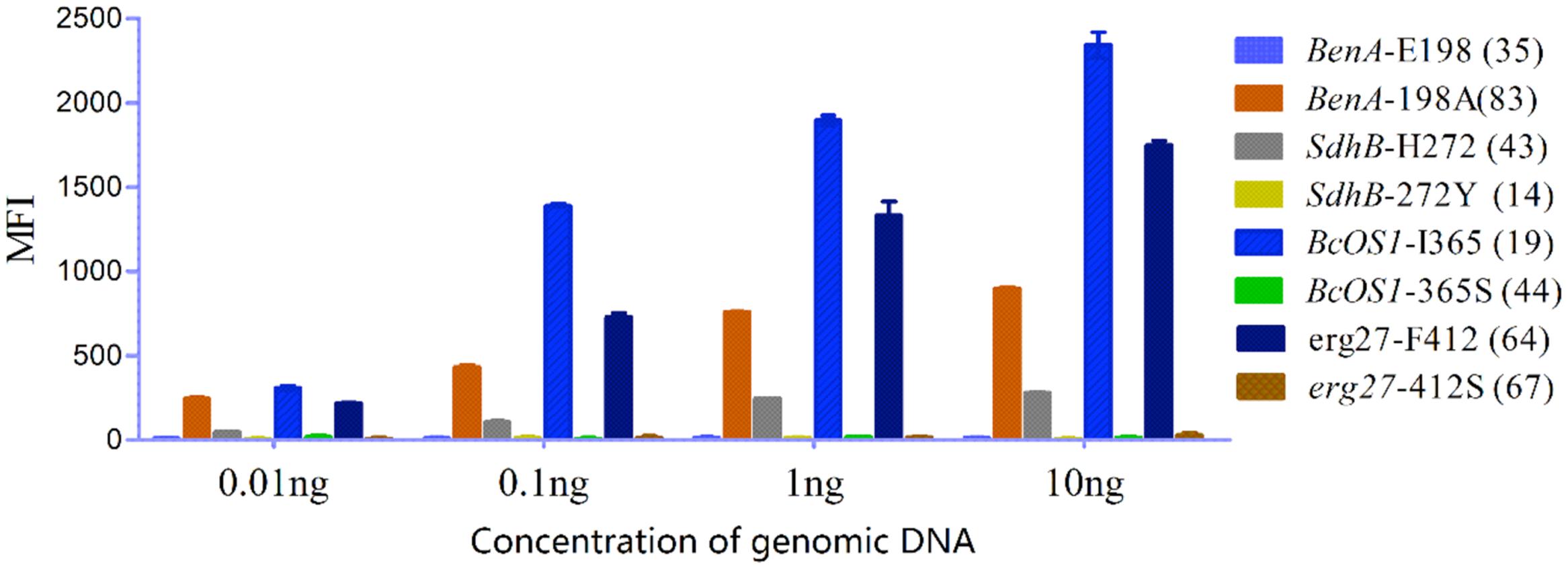
FIGURE 4. Detection limit of genomic DNA. Ten-fold serial dilutions of the field isolate of Botrytis cinerea genomic DNA template were tested with the suspension assay. The data shown are the means plus SD (n = 3).
Assay Sensitivity
Serial dilutions of Mut plasmid templates (10–104 copies) were mixed with 10 ng WT genomic DNA (corresponding to 2.2 × 105 genomic DNA copies per reaction), as shown in Figure 5, and a significant concentration-dependent relationship was observed for each Mut allele. The suspension assay could detect 0.45% of BenA-198A, BcOS1-365S and erg27-412S, and detected 4.5% of SdhB-272Y when these mutations were mixed within the genomic DNA background. These results indicate that the beads-based array had a high sensitivity.

FIGURE 5. Detection sensitivity of fungicide-resistance mutations at four sites. Ten-fold serial dilutions of the Mut plasmid template against the WT genomic DNA template were tested with the suspension assay. (A) BenA-198A plasmid mixed with WT genomic DNA. (B) SdhB-272Y plasmid mixed with WT genomic DNA. (C) BcOS1-365S plasmid mixed with WT genomic DNA. (D) erg-412S plasmid mixed with WT genomic DNA. The data shown are the means plus SD (n = 3).
Assay Reproducibility
To assess reproducibility of the assay, three independent assays were performed on different days. In each reaction, individual plasmid DNA aliquots (1 ng/μL) were used as templates for 4-plex PCR. The measurement of each sample was performed three times, and the mean MFI values were calculated. Results of reproducibility assays are shown in Table 4. The coefficient of variation (CV) for each probe was below 10%, indicating high reproducibility.
Sample Analysis
Ten field strains of B. cinerea were genotyped using the Bio-Plex suspension array. The measurement of each sample was performed twice, and results are shown in Table 5. Some alleles at one locus were found to be neither WT nor Mut using this method, illustrating that other mutations exist. To identify the accuracy of the assay, sequencing of each sample was performed. Sequencing results corresponded to the suspension array (Table 6). Alleles that could not be detected using the beads-based assay correspond to other mutations. For instance, the BenA gene in sample 1 was neither WT nor E198A, but rather contained the E198V mutation. These results indicate that this high-throughput platform can simultaneously detect eight alleles within a single sample volume. The results from this method are clear, intuitive, and highly accurate.
Discussion
Botrytis cinerea is a widespread fungus that causes gray mold rot in many plants. Due to the different fungicide-resistant molecular mechanisms, investigating the large numbers of resistant strains in the field will require a massive amount of work. However, none of the preexisting molecular methods meet the high-throughput demands for detection presently required. Here, we successfully developed and validated a multiplex microbead-based suspension array for simultaneous detection of eight alleles using the Bio-Plex 200 platform. This method will be broadly applicable in the field of plant pathology.
The microbead-based suspension array combines advanced fluidics, optics, and digital signal processing. The platform provides a sensitive and ideal method for genotyping large numbers of samples at a relatively low cost. We successfully developed and validated a consolidated microbead-based genotyping platform for simultaneous detection of eight alleles in a single reaction. Four basic steps were included in this assay: (i) multiplex PCR, (ii) single-tube ASPE PCR with tagged primers, (iii) hybridization of single-stranded PCR products to microbeads carrying anti-TAG sequence, and (iv) detection on the Bio-Plex 200 platform.
With respect to the first step, we designed several primers for each gene. Different primer mixtures for the four genes were used to screen the optimized combination to ensure specificity of amplification. We also found that the 4-plex primers influenced the MFI of negative control samples. Some unsuitable primers resulted in non-specific hybridization with microbeads. After PCR primers were determined, a multiplex PCR assay was optimized for several factors, including annealing temperature, and concentrations of four primer pairs. Gel imaging illustrates the high specificity of the PCR primers used in the multiplex reaction under optimized conditions (data not shown). Because multiplex PCR was the first step of the high throughput platform, it is essential that this reaction be as specific as possible to minimize potential problems.
Multiplex ASPE PCR incorporated eight allele-specific primers to specifically target WT or mutant sites. Each 5′ end of the ASPE primer attached to a unique TAG sequence. The 24-base TAG oligonucleotides only contain three kinds of bases and exclude guanine (G). xTAG technology ensures the same annealing temperature and hybridization efficiency, so that cross hybridization between targets and microbeads can be effectively avoided. Artificial changes of nucleotides were generally introduced into the 3′ ends of ASPE primers to improve specificity. A series of allele-specific primers have been screened by real-time PCR to identify the eight alleles in our laboratory, and each primer introduced additional mutations. However, signal values that were too low were observed in suspension assays when using the same primers as used for real-time PCR. These results indicate that ASPE primers that introduced additional mutations were not suitable for this experiment. Later PCR cycles generated only single-stranded biotinylated products. This greatly improved the sensitivity of the assay and allowed for simple optimization.
Biotinylated ASPE PCR amplicons with TAG sequences were hybridized to complementary probes (anti-TAG). The eight complementary probes were each coupled to a unique color-coded microsphere. Hybridization temperature affects signal output, so 54 and 37°C were selected to identify the optimal temperature in this assay. When the temperature was 54°C, the MFI of the blank was not affected. However, the MFI of targets was lower than when the hybridization temperature was 37°C. We also found that using 1× Tm buffer containing 0.1% BSA to dilute SAPE can effectively reduce the background.
There were nine no calls obtained with the beads-based assay from 10 samples because the minimum signal requirements were not met (Table 5). Sequencing results indicated that these nine calls corresponded to other mutation types (Table 6) not within the scope of detection in this suspension assay. Except for the nine non-called alleles, the concordance between the beads-based assay and DNA sequencing was 100%. An advantage of the suspension assay is that the resulting data are easier to interpret. All results of the 10 samples were clear at a glance and can be obtained in a single day, whereas analysis of sequencing results requires additional time.
Although this assay requires four basic steps, it still saves time and effort compared to other traditional methods once reaction conditions are determined. The Bio-Plex platform uses 96-well plates, so 96 samples can be detected in one round of reactions. This is equivalent to an output of 96 × 8 = 768 genotype designations. If using traditional PCR to distinguish eight alleles, 768 reactions in 768 wells would be needed, which would be time-consuming and introduce more possibilities to make mistakes.
The Bio-Plex 200 platform allows for up to 100 different analytes to be measured simultaneously in a single reaction, so researchers can personalize their experiments according to different requirements. For this microbead-based method, more mutations in BenA, SdhB, BcOS1, and erg27 could be detected: for instance, F200Y and E198V/K in the BenA gene (Yarden and Katan, 1993), P225T/F/L and H272Y/R in the SdhB gene (De Miccolis et al., 2014), I365R/N, Q369H/P and N373S in the BcOS1 gene (Cui et al., 2004; Grabke et al., 2014), and F412I/V in the erg27 gene (Fillinger et al., 2008). All of these mutations have been reported to be associated with fungicide resistance. Reaction conditions for multiplex PCR would not need to be further optimized; screening for these mutants would only require developing TAG-ASPE primers and microbeads corresponding to these other alleles. The microbead-based assay is flexible, and researchers can use it to design highly personalized experiments.
As with any technology, there are also some limitations of suspension arrays. First, the platform requires a relatively high start-up cost due to the commercial beads and instrument. Second, as with most traditional methods, it can only analyze known fungicide-resistance mutations. Third, this microbead-based assay requires two PCR amplifications, so it is a qualitative method and cannot be used for quantification.
This is the first report that demonstrates simultaneous detection of resistance to benzimidazoles, dicarboximides, SDHIs, and SBIs. The high-throughput capacity of the bead-based methods in fungicide resistance detection is unmatched. All results show that this multiplex, accurate, flexible, and sensitive assay represents a new efficient genotyping tool for fungicide resistance monitoring and administering of field strains of B. cinerea. The protocol presented in this study will be helpful to researchers for characterizing field strains of B. cinerea.
Author Contributions
XZ wrote the paper and performed most of this work. BL participated in designing and screening of ASPE primers. FX and PZ interpreted the results and revised the paper. XM supervised the entire study. All authors reviewed the manuscript.
Funding
This work was funded by the special Fund for Agro-scientific Research in the Public Interest (No. 201303023).
Conflict of Interest Statement
The authors declare that the research was conducted in the absence of any commercial or financial relationships that could be construed as a potential conflict of interest.
Acknowledgments
We thank Professor Jingao Dong from the Agricultural University of Hebei (Hebei, China) for providing the Bc05.10 strain of B. cinerea, and Professor Chaoxi Luo from Huazhong Agricultural University (Hubei, China) for providing field strains. We also thank Haibao Zhao from Bio-Rad for providing technical guidance, and Zhi Xie from Luminex Corporation for thorough assistance with TAG sequence design.
References
Agbagwa, I. O., Datta, S., Patil, P. G., Singh, P., and Nadarajan, N. (2012). A protocol for high-quality genomic DNA extraction from legumes. Genet. Mol. Res. 11, 4632–4639. doi: 10.4238/2012.September.14.1
Banno, S., Fukumori, F., Ichiishi, A., Okada, K., Uekusa, H., Kimura, M., et al. (2008). Genotyping of benzimidazole-resistant and dicarboximide-resistant mutations in Botrytis cinerea using real-time polymerase chain reaction assays. Phytopathology 98, 397–404. doi: 10.1094/PHYTO-98-4-0397
Bardas, G. A., Veloukas, T., Koutita, O., and Karaoglanidis, G. S. (2010). Multiple resistance of Botrytis cinerea from kiwifruit to SDHIs, QoIs and fungicides of other chemical groups. Pest Manag. Sci. 66, 967–973. doi: 10.1002/ps.1968
Billard, A., Laval, V., Fillinger, S., Leroux, P., Lachaise, H., Beffa, R., et al. (2012). The allele-specific probe and primer amplification assay, a new real-time PCR method for fine quantification of single-nucleotide polymorphisms in pooled DNA. Appl. Environ. Microbiol. 78, 1063–1068. doi: 10.1128/AEM.06957-11
Chatzidimopoulos, M., Ganopoulos, I., Vellios, E., Madesis, P., Tsaftaris, A., and Pappas, A. C. (2014). Development of a two-step high-resolution melting (HRM) analysis for screening sequence variants associated with resistance to the QoIs, benzimidazoles and dicarboximides in airborne inoculum of Botrytis cinerea. FEMS Microbiol. Lett. 360, 126–131. doi: 10.1111/1574-6968.12594
Cui, W., Beever, R. E., Parkes, S. L., and Templeton, M. D. (2004). Evolution of an osmosensing histidine kinase in field strains of Botryotinia fuckeliana (Botrytis cinerea) in response to dicarboximide fungicide usage. Phytopathology 94, 1129–1135. doi: 10.1094/PHYTO.2004.94.10.1129
Cui, W., Beever, R. E., Parkes, S. L., Weeds, P. L., and Templeton, M. D. (2002). An osmosensing histidine kinase mediates dicarboximide fungicide resistance in Botryotinia fuckeliana (Botrytis cinerea). Fungal Genet. Biol. 36, 187–198. doi: 10.1016/S1087-1845(02)00009-9
De Miccolis, A. R., Masiello, M., Rotolo, C., Pollastro, S., and Faretra, F. (2014). Molecular characterisation and detection of resistance to succinate dehydrogenase inhibitor fungicides in Botryotinia fuckeliana (Botrytis cinerea). Pest Manag. Sci. 70, 1884–1893. doi: 10.1002/ps.3748
De Miccolis, A. R., Rotolo, C., Masiello, M., Pollastro, S., Ishii, H., and Faretra, F. (2012). Genetic analysis and molecular characterisation of laboratory and field mutants of Botryotinia fuckeliana (Botrytis cinerea) resistant to QoI fungicides. Pest Manag. Sci. 68, 1231–1240. doi: 10.1002/ps.3281
Dean, R., Van Kan, J. A., Pretorius, Z. A., Hammond-Kosack, K. E., Di Pietro, A., Spanu, P. D., et al. (2012). The Top 10 fungal pathogens in molecular plant pathology. Mol. Plant Pathol. 13, 414–430. doi: 10.1111/j.1364-3703.2011.00783.x
Debieu, D., Bach, J., Montesinos, E., Fillinger, S., and Leroux, P. (2013). Role of sterol 3-ketoreductase sensitivity in susceptibility to the fungicide fenhexamid in Botrytis cinerea and other phytopathogenic fungi. Pest Manag. Sci. 69, 642–651. doi: 10.1002/ps.3418
Dunbar, S. A. (2006). Applications of Luminex xMAP technology for rapid, high-throughput multiplexed nucleic acid detection. Clin. Chim. Acta 363, 71–82. doi: 10.1016/j.cccn.2005.06.023
Dunbar, S. A., and Jacobson, J. W. (2007). Quantitative, multiplexed detection of Salmonella and other pathogens by Luminex xMAP suspension array. Methods Mol. Biol. 394, 1–19. doi: 10.1007/978-1-59745-512-1_1
Fernandez-Ortuno, D., Grabke, A., Li, X., and Schnabel, G. (2015). Independent emergence of resistance to seven chemical classes of fungicides in Botrytis cinerea. Phytopathology 105, 424–432. doi: 10.1094/PHYTO-06-14-0161-R
Fillinger, S., Ajouz, S., Nicot, P. C., Leroux, P., and Bardin, M. (2012). Functional and structural comparison of pyrrolnitrin- and iprodione-induced modifications in the class III histidine-kinase Bos1 of Botrytis cinerea. PLoS ONE 7:e42520. doi: 10.1371/journal.pone.0042520
Fillinger, S., Leroux, P., Auclair, C., Barreau, C., Al, H. C., and Debieu, D. (2008). Genetic analysis of fenhexamid-resistant field isolates of the phytopathogenic fungus Botrytis cinerea. Antimicrob. Agents Chemother. 52, 3933–3940. doi: 10.1128/AAC.00615-08
Glushakova, L. G., Bradley, A., Bradley, K. M., Alto, B. W., Hoshika, S., Hutter, D., et al. (2015). High-throughput multiplexed xMAP Luminex array panel for detection of twenty two medically important mosquito-borne arboviruses based on innovations in synthetic biology. J. Virol. Methods 214, 60–74. doi: 10.1016/j.jviromet.2015.01.003
Grabke, A., Fernandez-Ortuno, D., Amiri, A., Li, X., Peres, N. A., Smith, P., et al. (2014). Characterization of iprodione resistance in Botrytis cinerea from strawberry and blackberry. Phytopathology 104, 396–402. doi: 10.1094/PHYTO-06-13-0156-R
Hahn, M. (2014). The rising threat of fungicide resistance in plant pathogenic fungi: Botrytis as a case study. J. Chem. Biol. 7, 133–141. doi: 10.1007/s12154-014-0113-1
Houser, B. (2012). Bio-Rad’s Bio-Plex(R) suspension array system, xMAP technology overview. Arch. Physiol. Biochem. 118, 192–196. doi: 10.3109/13813455.2012.705301
Ishii, H., Fountaine, J., Chung, W. H., Kansako, M., Nishimura, K., Takahashi, K., et al. (2009). Characterisation of QoI-resistant field isolates of Botrytis cinerea from citrus and strawberry. Pest Manag. Sci. 65, 916–922. doi: 10.1002/ps.1773
Lee, S. H., Choi, H. B., Yu, S. Y., Chang, U. J., Kim, C. K., and Kim, H. J. (2015). Detection of first-line anti-tuberculosis drug resistance mutations by allele-specific primer extension on a microsphere-based platform. Ann. Lab. Med. 35, 487–493. doi: 10.3343/alm.2015.35.5.487
Leroux, P., Fritz, R., Debieu, D., Albertini, C., Lanen, C., Bach, J., et al. (2002). Mechanisms of resistance to fungicides in field strains of Botrytis cinerea. Pest Manag. Sci. 58, 876–888. doi: 10.1002/ps.566
Leroux, P., Gredt, M., Leroch, M., and Walker, A. S. (2010). Exploring mechanisms of resistance to respiratory inhibitors in field strains of Botrytis cinerea, the causal agent of gray mold. Appl. Environ. Microbiol. 76, 6615–6630. doi: 10.1128/AEM.00931-10
Li, D., Wang, Y., Lau, C., and Lu, J. (2014). xMAP array microspheres based stem-loop structured probes as conformational switches for multiplexing detection of miRNAs. Anal. Chem. 86, 10148–10156. doi: 10.1021/ac501989b
Mbengue, M., Navaud, O., Peyraud, R., Barascud, M., Badet, T., Vincent, R., et al. (2016). Emerging trends in molecular interactions between plants and the broad host range fungal pathogens Botrytis cinerea and Sclerotinia sclerotiorum. Front. Plant Sci. 7:422. doi: 10.3389/fpls.2016.00422
Munoz, C., Gomez, T. S., and Volpe, M. L. (2009). Tetra primer ARMS-PCR for identification of SNP in beta-tubulin of Botrytis cinerea, responsible of resistance to benzimidazole. J. Microbiol. Methods 78, 245–246. doi: 10.1016/j.mimet.2009.06.007
Naciff, J. M., Richardson, B. D., Oliver, K. G., Jump, M. L., Torontali, S. M., Juhlin, K. D., et al. (2005). Design of a microsphere-based high-throughput gene expression assay to determine estrogenic potential. Environ. Health Perspect. 113, 1164–1171. doi: 10.1289/ehp.7843
Oshima, M., Fujimura, M., Banno, S., Hashimoto, C., Motoyama, T., Ichiishi, A., et al. (2002). A point mutation in the two-component histidine kinase bcos-1 gene confers dicarboximide resistance in field isolates of Botrytis cinerea. Phytopathology 92, 75–80. doi: 10.1094/PHYTO.2002.92.1.75
Ozaki, S., Kato, K., Abe, Y., Hara, H., Kubota, H., Kubushiro, K., et al. (2014). Analytical performance of newly developed multiplex human papillomavirus genotyping assay using Luminex xMAP technology (Mebgen HPV Kit). J. Virol. Methods 204, 73–80. doi: 10.1016/j.jviromet.2014.04.010
Ozaki, S., Kitamura, S., Hara, H., Shimoyama, Y., Kubota, H., Abe, Y., et al. (2012). Clinical evaluation of a novel multiplex HPV genotyping reagent using the luminex xMAP technology. Rinsho Byori 60, 621–626.
Preuner, S., and Lion, T. (2013). Species-specific identification of a wide range of clinically relevant fungal pathogens by the Luminex (®) xMAP technology. Methods Mol. Biol. 968, 119–139. doi: 10.1007/978-1-62703-257-5_9
Spierings, G., and Dunbar, S. A. (2013). Pharmacogenetics using Luminex(R) xMAP(R) technology: a method for developing a custom multiplex single nucleotide polymorphism mutation assay. Methods Mol. Biol. 1015, 115–126. doi: 10.1007/978-1-62703-435-7_7
Thierry, S., and Derzelle, S. (2015). Multiplexed genotyping of Bacillus anthracis by Luminex xMap suspension array. Methods Mol. Biol. 1247, 401–412. doi: 10.1007/978-1-4939-2004-4_29
Van der Heyden, H., Dutilleul, P., Brodeur, L., and Carisse, O. (2014). Spatial distribution of single-nucleotide polymorphisms related to fungicide resistance and implications for sampling. Phytopathology 104, 604–613. doi: 10.1094/PHYTO-03-13-0085-R
Wang, Y., Shi, J., Wu, Y., Xu, W., Wang, Q., Zhang, J., et al. (2012). Use of Luminex xMAP bead-based suspension array for detecting microRNA in NSCLC tissues and its clinical application. Tumori 98, 792–799. doi: 10.1700/1217.13505
Yang, L., Tran, D. K., and Wang, X. (2001). BADGE, Beads Array for the Detection of Gene Expression, a high-throughput diagnostic bioassay. Genome Res. 11, 1888–1898. doi: 10.1101/gr.190901
Yarden, O., and Katan, T. (1993). Mutation leading to substitutions at amino acids 198 and 200 of beta-tubulin that correlated with benomyl-resistance phenotypes of field strains of Botrytis cinerea. Phytopathology 83, 1478–1483. doi: 10.1094/Phyto-83-1478
Yin, Y. N., Kim, Y. K., and Xiao, C. L. (2011). Molecular characterization of boscalid resistance in field isolates of Botrytis cinerea from apple. Phytopathology 101, 986–995. doi: 10.1094/PHYTO-01-11-0016
Yin, Y. N., Kim, Y. K., and Xiao, C. L. (2012). Molecular characterization of pyraclostrobin resistance and structural diversity of the cytochrome b gene in Botrytis cinerea from apple. Phytopathology 102, 315–322. doi: 10.1094/PHYTO-08-11-0234
Yourman, L. F., Jeffers, S. N., and Dean, R. A. (2000). Genetic analysis of isolates of Botrytis cinerea Sensitive and resistant to benzimidazole and dicarboximide fungicides. Phytopathology 90, 851–859. doi: 10.1094/PHYTO.2000.90.8.851
Keywords: Botrytis cinerea, fungicide resistance, multiplex detection, suspension array, ASPE PCR
Citation: Zhang X, Xie F, Lv B, Zhao P and Ma X (2016) Suspension Array for Multiplex Detection of Eight Fungicide-Resistance Related Alleles in Botrytis cinerea. Front. Microbiol. 7:1482. doi: 10.3389/fmicb.2016.01482
Received: 27 May 2016; Accepted: 06 September 2016;
Published: 21 September 2016.
Edited by:
Vijai Kumar Gupta, National University of Ireland, Galway, IrelandReviewed by:
Ram Prasad, Amity University, IndiaYi-Ping Hou, Nanjing Agricultural University, China
Copyright © 2016 Zhang, Xie, Lv, Zhao and Ma. This is an open-access article distributed under the terms of the Creative Commons Attribution License (CC BY). The use, distribution or reproduction in other forums is permitted, provided the original author(s) or licensor are credited and that the original publication in this journal is cited, in accordance with accepted academic practice. No use, distribution or reproduction is permitted which does not comply with these terms.
*Correspondence: Xuemei Ma, eG1tYUBianV0LmVkdS5jbg==
 Xin Zhang
Xin Zhang Fei Xie
Fei Xie Baobei Lv
Baobei Lv Pengxiang Zhao
Pengxiang Zhao Xuemei Ma
Xuemei Ma

